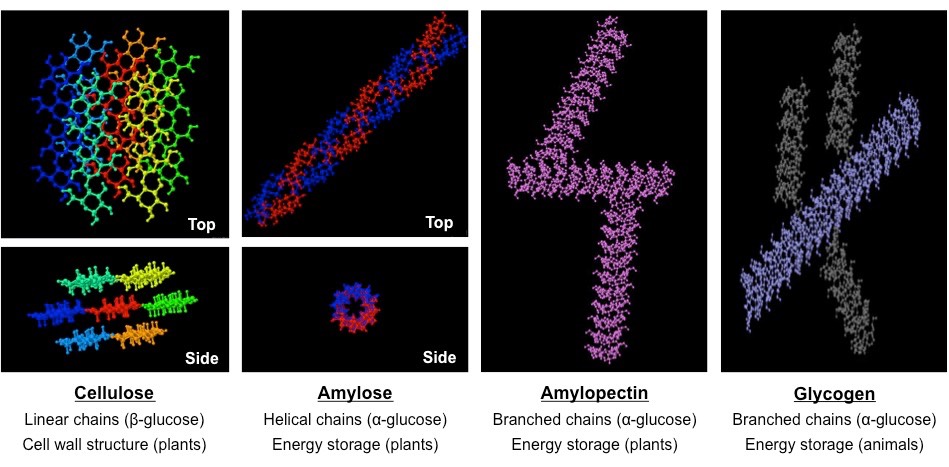![]()
Application:
• Structure and function of cellulose and starch in plants and glycogen in humans
Polysaccharides are carbohydrate polymers comprised of many (hundreds to thousands) monosaccharide monomers
The type of polymer formed depends on the monosaccharide subunits involved and the bonding arrangement between them
Three key polymers can be made from glucose monosaccharides – cellulose, starch (in plants) and glycogen (in animals)
Cellulose
Cellulose is a structural polysaccharide that is found in the cell wall of plants
It is a linear molecule composed of β-glucose subunits (bound in a 1-4 arrangement)
Because it is composed of β-glucose, it is indigestible for most animals (lack the enzyme required to break it down)
- Ruminants (e.g. cows) may digest cellulose due to the presence of helpful bacteria in a specialised stomach
- Caecotrophs (e.g. rabbits) will re-ingest specialised faeces that contain digested cellulose (broken down in the caecum)
Starch
Starch is an energy storage polysaccharide found in plants
It is composed of α-glucose subunits (bound in a 1-4 arrangement) and exists in one of two forms – amylose or amylopectin
- Amylose is a linear (helical) molecule while amylopectin is branched (contains additional 1-6 linkages)
- Amylose is harder to digest and less soluble, however, as it takes up less space, is the preferred storage form in plants
Glycogen
Glycogen is an energy storage polysaccharide formed in the liver in animals
It is composed of α-glucose subunits linked together by both 1-4 linkages and 1-6 linkages (branching)
- It is akin to amylopectin in plants, but is more highly branched (1-6 linkages occur every ~10 subunits as opposed to ~20)
Polysaccharides of Glucose

![]()
Skill:
• Use of molecular visualisation software to compare cellulose, starch and glycogen
To view the sugar structures* via interactive pop-ups, click on the name of the structure below:
* Structures generously provided by Richard Steane and Professor Pilar Roca – run using the JsMol applet
Molecular Images of Glucose Polymers

